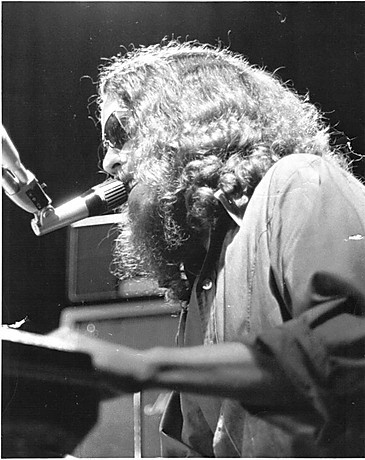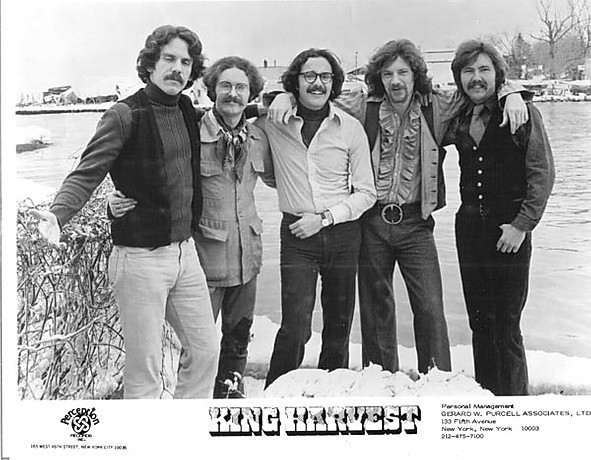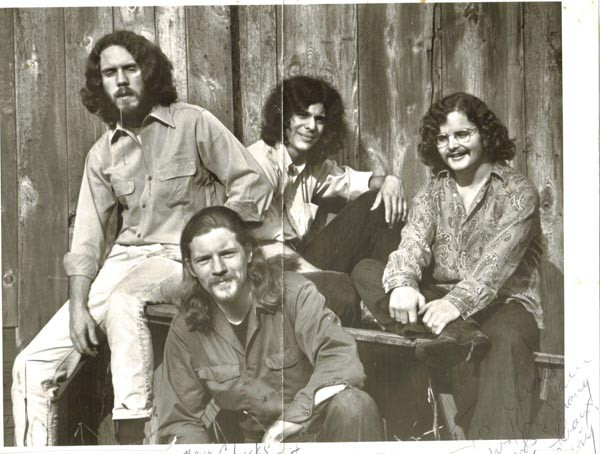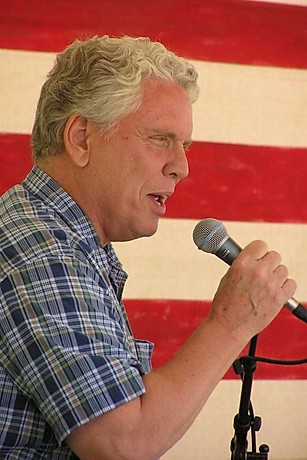You’ve likely hummed along to it at weddings, parties, or while cruising down the highway with the windows down. “Dancing in the Moonlight” is one of those feel-good songs that instantly lifts your spirits. But the sunny disposition of this classic track belies a dark and deeply personal origin story. Sherman Kelly, the songwriter behind this enduring hit, experienced a life-altering event that transformed trauma into a timeless anthem of joy and escapism. This is the untold story of how “Dancing in the Moonlight” came to be, straight from the songwriter himself.

Sherman Kelly performing on stage in the 1970s, capturing the energy of the era when “Dancing in the Moonlight” was gaining popularity.
The story begins not on a dance floor bathed in moonlight, but with a canceled concert and a curious online comment. Like many music fans in early May 2020, I was facing concert cancellations due to the global pandemic. Disappointed about missing a show featuring Pure Prairie League, Poco, and Orleans, I found myself on YouTube, revisiting performances by these bands. It was during an Orleans video of them covering “Dancing in the Moonlight” that I noticed an intriguing comment – it was from Sherman Kelly himself, posted just months prior.
As someone fascinated by the stories behind iconic songs, the comment sparked an immediate question: Could I reach out to Sherman Kelly and hear the story of “Dancing in the Moonlight” directly from its creator? To my delight, I did, and Sherman Kelly agreed to share the incredible and unexpected journey of his most famous song.
The genesis of “Dancing in the Moonlight” traces back to 1969, when Kelly was running a nightclub in St. Thomas, in the Virgin Islands. An ill-fated day trip to St. Croix on a rented yacht took a dramatic turn when Kelly and his girlfriend succumbed to severe seasickness. Upon reaching St. Croix, while their companions went ashore for dinner, Kelly and his girlfriend, still unwell, decided to forgo food and rest on the boat. However, the sight of the yacht’s mast swaying in the harbor convinced them to seek lodging in town for the night, hoping to avoid further seasickness.
Unfortunately, in his disoriented state, Kelly had left his wallet on the yacht, leaving them without funds for a hotel. They approached a small innkeeper, explaining their predicament and promising to settle the bill in the morning. The innkeeper’s shocking response, a proposition to Kelly’s girlfriend in exchange for accommodation, forced them to seek shelter elsewhere. After another rejection at a second inn, they were left with no choice but to sleep on the beach.
“It’s a beautiful night. Why don’t we just stretch out on the beach?” Kelly recalled his girlfriend suggesting. “So we did. And that’s all I remember very clearly.”
What followed was a horrific ordeal pieced together from fragmented memories and accounts from others. While sleeping on the beach, Kelly and his girlfriend were brutally attacked by a gang. Kelly was viciously beaten with baseball bats by five members of the Fountain Valley Gang, a notorious group that would later terrorize tourists in St. Croix. His girlfriend was subjected to a brutal assault. In a moment of resilience amidst the violence, Kelly regained consciousness and fought back, creating enough disturbance to frighten off the attackers.

King Harvest band members in 1972, the year their rendition of “Dancing in the Moonlight” became a national hit, showcasing the lineup that brought the song to mainstream audiences.
Severely injured and drifting in and out of consciousness, Kelly and his girlfriend managed to find their way to the local hospital. They unknowingly became victims of the Fountain Valley Gang, infamous for a later massacre in 1972 that tragically impacted St. Croix’s tourism industry for years.
Kelly’s hospital stay was harrowing. He vividly remembers waking to the screams of his roommate, followed by doctors declaring the other patient’s death and expressing doubts about Kelly’s own survival. Despite the grim prognosis, Kelly defied expectations and survived. After days in the St. Croix hospital, he returned to St. Thomas and then to New York for further medical treatment to repair his facial injuries and other wounds.
Returning to his home in Ithaca, New York, Kelly faced a long and painful recovery. Constant headaches and lingering pain prevented him from returning to performing with a band. However, this period of convalescence became an unexpected catalyst for creativity. It was during this challenging time that the seeds of “Dancing in the Moonlight” were sown.
“I envisioned an alternate reality, the dream of a peaceful and joyous celebration of life. It was just me imagining a better world than the one I had just experienced in St. Croix,” Kelly explained. From the depths of a traumatic experience, an unlikely spark of hope and joy ignited, leading to the creation of a song that would resonate with millions.
The initial response to “Dancing in the Moonlight” was overwhelmingly positive. “It was amazing. People liked the song right from the start. I liked it, but I wouldn’t have predicted that it would become a big hit,” Kelly admitted. The song’s journey from personal trauma to public adoration was just beginning.
Before King Harvest propelled “Dancing in the Moonlight” to national fame, the song first appeared on record by Boffalongo, a band Kelly formed with his brother Wells Kelly and future Orleans member Larry Hoppen in 1970. The Boffalongo version, featured on their album “Beyond Your Head,” showcased Sherman Kelly on lead vocals. However, Kelly is self-deprecating about his vocal performance on this initial recording.
“The first time I was in a recording studio for that version, we had these producers who thought it was a good idea to give me cocaine. That was probably the worst idea,” Kelly revealed. He described a chaotic and unproductive recording session, exacerbated by misguided attempts to enhance his performance, resulting in a vocal track he deemed “horrible.”

Boffalongo, Sherman Kelly’s band in 1970, captured in a promotional shot around the time they first recorded “Dancing in the Moonlight”, showcasing the early days of the song’s journey.
Despite Kelly’s vocal reservations, the Boffalongo version gained regional popularity. Another group, High Broom, also recorded “Dancing in the Moonlight” in 1970, releasing it on Island Records, but this version did not chart. When Boffalongo disbanded, Wells Kelly joined King Harvest, a band featuring Doc Robinson, also a former Boffalongo member. It was Wells who introduced “Dancing in the Moonlight” to King Harvest.
King Harvest’s rendition of “Dancing in the Moonlight,” with Doc Robinson on lead vocals, became the definitive version. Released as a single in 1972, it soared up the charts, reaching No. 10 on the Cash Box Top 100 and No. 13 on the Billboard Hot 100. The success of the song led King Harvest to invite Sherman Kelly to tour with them in the summer of 1972. During these live performances, Robinson handled the lead vocals, while Sherman Kelly provided harmonies.
Kelly humorously recounts a critic’s assessment of his singing: “As a singer, Sherman Kelly is not too bad of a songwriter.” While acknowledging Robinson’s vocal prowess, Kelly found that the touring life with King Harvest was not for him, lasting only for that one summer. The transient nature of life on the road, while initially exciting, quickly lost its appeal.
Wells Kelly later reunited with John Hall and Larry Hoppen to form Orleans. Orleans also recorded “Dancing in the Moonlight,” further cementing the song’s legacy. Even today, a current iteration of Orleans, including John Hall and Larry Hoppen’s brothers, Lance and Lane Hoppen, continues to perform “Dancing in the Moonlight” in their sets, keeping the song alive for new generations. Larry Hoppen passed away in 2012, but his musical legacy, intertwined with “Dancing in the Moonlight,” endures.

Sherman Kelly in a recent photo, reflecting on his career and the enduring impact of “Dancing in the Moonlight” decades after its creation.
Sherman Kelly’s life journey extended far beyond the realm of music. A graduate of Cornell University with degrees in psychology and English, he pursued further studies in Paris, Switzerland, and New York City before penning his famous song. Following the tragic death of his brother Wells in 1984, Sherman Kelly transitioned away from the music industry, finding a new calling in social work and psychotherapy. He earned a master’s degree from Syracuse University and dedicated many years to helping others as a psychotherapist until his retirement.
Despite stepping away from the forefront of music, Kelly returned in 2008 with the album “Burnin’ the Candle,” featuring collaborations with his late brother. “Dancing in the Moonlight” continued to evolve and reach new audiences. Toploader’s cover in 2000 became another hit, introducing the song to a new generation. The song has also been featured in films, television shows, and video games, including “Guardians of the Galaxy: The Telltale Signs” in 2017, demonstrating its timeless appeal and adaptability.
From its traumatic origins on a St. Croix beach to its global recognition as a feel-good anthem, “Dancing in the Moonlight” is a testament to the transformative power of music. Sherman Kelly’s personal journey, marked by both hardship and resilience, is deeply woven into the fabric of this beloved song. It stands as a reminder that even from the darkest experiences, art and beauty can emerge, offering solace and joy to listeners under the moonlight, and beyond.

